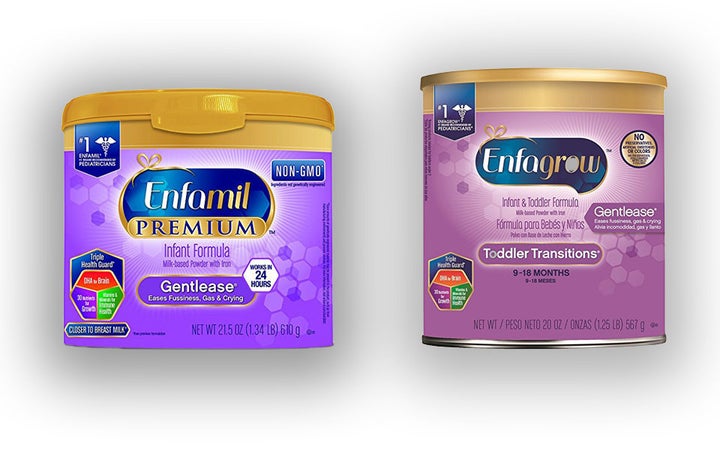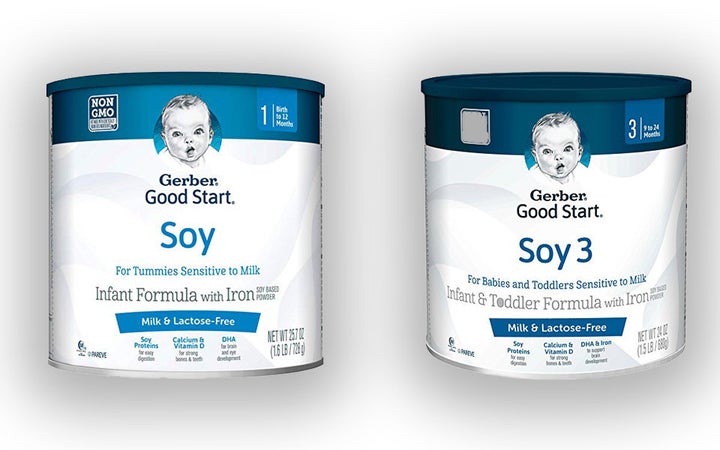
The number of Americans who breastfeed their children has risen steadily over the past few decades ― a public health win that results in better nutrition and lower health risks for mothers and babies. But this positive development is at odds with the interests of the baby formula industry, whose sales in recent years have flattened in the U.S.
Companies that make baby formula ― Nestle, Abbott, Mead Johnson and Danone are the top four worldwide ― have responded by heavily marketing other products within the category of “formula food.” One particular product that started showing up on supermarket shelves in the 1980s has now become the global industry’s fastest growing product: toddler formula.
Toddler formula, marketed for kids 9 months and up, is meant to be a “nutritional supplement” ensuring that children receive the nutrients they need as they transition from breast milk or baby formula to solid food, according to the formula makers.
But the World Health Organization and pediatric nutrition experts say toddler formula and toddler milks are unnecessary because small children can get all the nutrients they need from a healthy whole-foods diet. Some experts even contend that toddler formulas are potentially harmful in the long run.

The vast majority of the toddler formulas on the market contain a combination of powdered milk, corn syrup or other added sweeteners, and vegetable oil ― plus some added vitamins and minerals. They also offer more sodium and less protein than whole cow’s milk, which is what the WHO and the American Academy of Pediatrics recommend for toddlers.
The experts say much of the marketing of toddler formulas suggests young children need these products to get their full nutrition, even though industry representatives insist the products are only meant to supplement whole foods.
Products like Enfagrow (see above) are labeled as “infant and toddler formula,” leading parents to believe the toddler milks are nutritionally similar to infant formula. They are often packaged in the same baby blues and pinks ― with happy graphics and promises of growth ― that decorate infant formula containers. And they’re positioned in the grocery aisle alongside infant formula. It’s not surprising that many parents may view them as the next logical step for feeding their growing child.
“That’s really a brilliant strategy as they’ve been able to create this new product, use their branding that they’ve established for their infant formulas and convince parents who are going through a very difficult transition phase [as they] try to get their infants to move from formula to adult food and healthy diets,” said Jennifer Harris from the Rudd Center for Food Policy & Obesity at the University of Connecticut.
The result? Toddler formula sales worldwide grew 53 percent between 2008 and 2013 ― the highest growth rate in the formula milk category ― according to a Public Health Nutrition study. U.S. ad spending on toddler formula jumped from $9.7 million in 2011 to $16.8 million in 2015, according to a Rudd Center report. Walmart spokesperson Erin Hulliberger told HuffPost that the product category has grown in popularity at the huge retail chain over the past few years.
And Harris said that preliminary findings from a study she’s led, set to be released in September, suggest that more than 40 percent of Americans may be feeding toddler formula and/or toddler milks to their kids ― some of them daily.
Companies are exploiting “the concern that parents have as they come off routine infant formula that their [children are] not getting the nutrition they need,” said Dr. Steve Abrams, who chairs the nutrition committee for the American Academy of Pediatrics. “That’s not an evidence-based conclusion. Parents shouldn’t feel the need to spend the money on this versus whole milk.”

Lucy Sullivan, executive director for the nonprofit 1,000 Days, which advocates in the U.S. and abroad for better early nutrition, took the warning further.
“Not only are these products unnecessary, but they’re unhealthy because they contain a lot of sugar and ingredients that are not good for little kids,” she said. “It’s about whether little kids should be drinking milk-based products that are effectively sugar-sweetened beverages.”
The American Heart Association recommends against serving added sugars to kids less than 2 years old. Nutrition experts point to research that indicates taste preferences are set at a young age and that exposing toddlers to excess sweetness could heighten their risk for obesity later in life.
“The bottom line is children learn to like what they eat,” nutrition researcher Julie Mannella said. “By giving them milk with added sugar, you’re teaching them that’s what milk is supposed to taste like.”
When asked about the WHO recommendations and experts’ complaints, a Nestle spokesperson told HuffPost, “We prioritize the health and well-being of young children and we take seriously our responsibility to provide nutritious food for them. That is why we are committed to offering a range of nutritious options including growing-up milks.”
‘Who Doesn’t Want Their Child To Do Well In Puzzles’
The tins and tubs of toddler formula benefit from a “halo effect,” Sullivan said. They look so much like the trusted infant formulas that parents feed their babies and that are strictly regulated by the WHO’s International Code of Marketing of Breast-milk Substitutes.
But the code ― which drew some attention this summer when the Trump administration reportedly pushed to soften a WHO resolution in favor of breastfeeding ― was adopted in 1981 and does not cover toddler formula. Subsequent WHO recommendations and resolutions have addressed the marketing of toddler formula, but member states are merely encouraged to implement that guidance.
As a result, unsubstantiated health claims are undermining the diets of very young children, argues Jennifer Pomeranz, assistant professor of public health policy and management at New York University’s College of Global Public Health and the lead author of a study on those misleading marketing practices.
Essentially, Pomeranz said, formula makers are “creating a category of a fake need that they can fill.” Their marketing suggests that toddler formula will provide missing nutrients, especially for “picky” or “fussy” eaters, and encourage brain growth.
The website for Enfagrow, a brand made by Mead Johnson, suggests that the added DHA ― a fatty acid found in fish oil ― makes toddler formula better than whole milk, which has no DHA. Formula companies tout the common additive in infant and toddler formulas as essential to a child’s growth ― even though nutrition experts say it’s not clear whether DHA is needed for brain development.
“Not only are these products unnecessary, but they're unhealthy because they contain a lot of sugar and ingredients that are not good for little kids.”
- Lucy Sullivan, executive director of the nonprofit 1,000 Days
Meanwhile, parents are misled into thinking their kids lack something as they transition to whole foods.
“Parents are trusting. If they see these messages on the package they trust them,” said Harris, who is also a co-author on Pomeranz’s marketing study. “They’re powerful messages ― I mean who doesn’t want their child to do well in puzzles and grow as much as possible and all of the good things?”
But “if your toddler is drinking whole milk, which is the recommendation, then they’re getting the calcium and vitamins they need,” Harris said.
When asked about the nutritional necessity of such formulas, the Nestle spokesperson stressed they “provide children above one year of age with key nutrients, such as vitamin D, vitamin A, iron, iodine, zinc and omega-3 fatty acids, which are important for healthy growth and development and which may be lacking in the diets of some young children.”
Instead of answering specific questions, the spokesperson directed HuffPost to an expert at the Infant Nutrition Council of America, which is funded by the top toddler formula companies.
Mead Johnson’s Enfagrow also claims to be the “#1 pediatrician approved” product ― even though toddler formulas are not recommended by any major pediatrician group. Lynn Kenney, the head of North American corporate communications for the Reckitt Benckiser Group, which owns Mead Johnson, said, “The #1 recommendation claim on Enfagrow is based on a survey of pediatricians in the U.S. regarding their most recommended brand of toddler beverage to moms of toddlers.”
She did not respond to a request to see that survey.
‘Toddler Formulas Are Kind Of A Cash Cow’
Toddlers may not need formula, but the products solve a sales problem not only for formula companies but also for the dairy industry. The market for milk products has diminished due in part to the worldwide push for more breastfeeding and falling global birthrates. Over the last few years, U.S. dairy farmers have struggled with a production glut ― and, as Sullivan pointed out, toddler formulas take some of that overflow.
“Toddler formulas are kind of a cash cow ― no pun intended ― for the dairy industry,” the 1,000 Days leader said.
That’s why dairy industry lobbyists were some of the loudest voices against additional rules that strengthened the International Code of Marketing of Breast-milk Substitutes in 2016.
Of course, the WHO is not the final say on the marketing of toddler formulas in the U.S. The Food and Drug Administration or the Federal Trade Commission could investigate the health claims. Those agencies haven’t stepped up, experts said, because there hasn’t been enough of a public outcry and the research on the potential risks of toddler formula is just catching up with its surge in popularity.
“This is the problem where FDA regulates on the grounds of human safety,” said Rafael Perez-Escamilla, a professor at the Yale School of Public Health. “They are not really empowered to challenge them from the perspective of being unnecessary.”
Perez-Escamilla stressed that some of the problem in the U.S. stems from the fact that the federal government hasn’t issued official guidelines for feeding children under the age of 2. They’re scheduled to come out in 2020. Many of the experts think the current lack of guidelines contributes to parents’ confusion.
Nutrition experts also worry about potential industry influence over such guidelines, especially given the Trump administration’s recent sympathy for the formula makers.
“Do we wait for a more public health friendly climate to push for these [guidelines] or do we charge forward and hope the public advocacy community is active enough to push back against what we’ve seen in the past and worry about now?” Sullivan asked. “We want these guidelines to be based on strong scientific evidence and not industry ― there’s a lot at stake.”
In the meantime, more and more kids are drinking toddler formula.
Language has been added to more fully explain how WHO has addressed toddler formulas.
